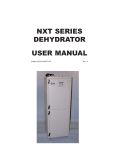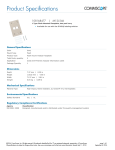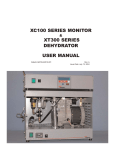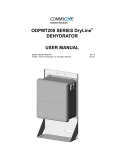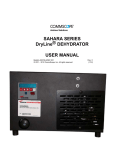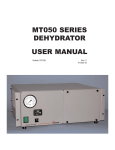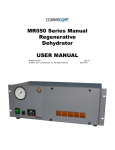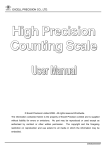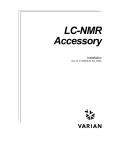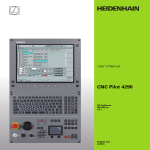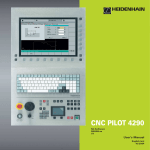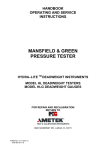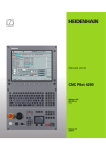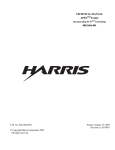Download MT SERIES DryLine® DEHYDRATOR USER MANUAL
Transcript
MT SERIES DryLine® DEHYDRATOR USER MANUAL Bulletin AE01B-A0496-001 © 2008 - 2011 CommScope, Inc. All rights reserved. Rev: F (12/11) MT Series DryLine® Dehydrator User Manual Table of Contents Section 1 General Information . . . . . . . . . . . . . . . . . . . . . . . . . . . . . . . . . . . . . . . 4 1.1 Introducing New DryLine® Dehydrator . . . . . . . . . . . . . . . . . . . . . . . . . . . . . . . . . . 4 1.2Description . . . . . . . . . . . . . . . . . . . . . . . . . . . . . . . . . . . . . . . . . . . . . . . . . . . . 4 1.3 Introducing the DryLine® Dehydrator . . . . . . . . . . . . . . . . . . . . . . . . . . . . . . . . . . .4 Section 2 Installation . . . . . . . . . . . . . . . . . . . . . . . . . . . . . . . . . . . . . . . . . . . . . 5 2.1 2.2 2.3 2.4 2.5 2.6 2.7 2.8 2.9 2.10 Section 3 Operation . . . . . . . . . . . . . . . . . . . . . . . . . . . . . . . . . . . . . . . . . . . . . 3.1 3.2 3.3 Section 4 Unpack Dehydrator and Inspect for Shipping Damage . . . . . . . . . . . . . . . . . . . . . . .5 Perform Pre-System Startup Test . . . . . . . . . . . . . . . . . . . . . . . . . . . . . . . . . . . . . 5 Placing the Dehydrator . . . . . . . . . . . . . . . . . . . . . . . . . . . . . . . . . . . . . . . . . . . .5 Figure 1 — Filter Bowls . . . . . . . . . . . . . . . . . . . . . . . . . . . . . . . . . . . . . . . . . . . 5 Install Polyethylene Tubing Lines . . . . . . . . . . . . . . . . . . . . . . . . . . . . . . . . . . . . . 6 Connection Procedure . . . . . . . . . . . . . . . . . . . . . . . . . . . . . . . . . . . . . . . . . . . . 6 Figure 2 — MT Series System configuration diagram Basic . . . . . . . . . . . . . . . . . . . 7 Figure 3 — MT Series System configuration diagram Multi-Line . . . . . . . . . . . . . . . . 8 Connect Alarm Wiring . . . . . . . . . . . . . . . . . . . . . . . . . . . . . . . . . . . . . . . . . . . . .9 Figure 4 — Upper terminal strip . . . . . . . . . . . . . . . . . . . . . . . . . . . . . . . . . . . . . .9 Connect to Power Supply . . . . . . . . . . . . . . . . . . . . . . . . . . . . . . . . . . . . . . . . . 10 Test the Unit . . . . . . . . . . . . . . . . . . . . . . . . . . . . . . . . . . . . . . . . . . . . . . . . . . 10 Connect to Dry Air Cable System . . . . . . . . . . . . . . . . . . . . . . . . . . . . . . . . . . . . 10 Purging Procedure . . . . . . . . . . . . . . . . . . . . . . . . . . . . . . . . . . . . . . . . . . . . . . 10 14 Pressure Monitoring and Control . . . . . . . . . . . . . . . . . . . . . . . . . . . . . . . . . . . . 14 Programming information . . . . . . . . . . . . . . . . . . . . . . . . . . . . . . . . . . . . . . . . . 14 Shutdown Procedure . . . . . . . . . . . . . . . . . . . . . . . . . . . . . . . . . . . . . . . . . . . . 14 Theory of Operation . . . . . . . . . . . . . . . . . . . . . . . . . . . . . . . . . . . . . . 15 4.1Dehydrator15 4.2 Dehydrator Control . . . . . . . . . . . . . . . . . . . . . . . . . . . . . . . . . . . . . . . . . . . . . 15 Figure 5 — Door Schematic . . . . . . . . . . . . . . . . . . . . . . . . . . . . . . . . . . . . . . . 16 Figure 6 — Chassis Schematic . . . . . . . . . . . . . . . . . . . . . . . . . . . . . . . . . . . . . 17 Section 5 Maintenance . . . . . . . . . . . . . . . . . . . . . . . . . . . . . . . . . . . . . . . . . . . 18 5.1 5.2 Section 6 Semi-Annual Preventive Maintenance Inspection . . . . . . . . . . . . . . . . . . . . . . . . . 18 Replace Compressor Air Filter . . . . . . . . . . . . . . . . . . . . . . . . . . . . . . . . . . . . . . 18 In Case of Difficulty . . . . . . . . . . . . . . . . . . . . . . . . . . . . . . . . . . . . . . . 19 2 MT Series DryLine® Dehydrator User Manual Section 7 Parts Replacement and Dehydrator Overhaul . . . . . . . . . . . . . . . . . . . . 21 7.1 7.2 7.3 7.4 7.5 7.6 7.7 7.8 7.9 7.10 7.11 7.12 7.13 7.14 Parts Replacement Procedures . . . . . . . . . . . . . . . . . . . . . . . . . . . . . . . . . . . . . 22 Unit Shutdown and Removal . . . . . . . . . . . . . . . . . . . . . . . . . . . . . . . . . . . . . . . 22 Door and Panel Removal . . . . . . . . . . . . . . . . . . . . . . . . . . . . . . . . . . . . . . . . . 22 Replace Power Switch . . . . . . . . . . . . . . . . . . . . . . . . . . . . . . . . . . . . . . . . . . . 22 Replace Circuit Breaker . . . . . . . . . . . . . . . . . . . . . . . . . . . . . . . . . . . . . . . . . . 22 Replace Time Delay Module . . . . . . . . . . . . . . . . . . . . . . . . . . . . . . . . . . . . . . . 22 Replace Compressor . . . . . . . . . . . . . . . . . . . . . . . . . . . . . . . . . . . . . . . . . . . . 22 Replace Heat Exchanger . . . . . . . . . . . . . . . . . . . . . . . . . . . . . . . . . . . . . . . . . . 23 Filter Bowl Replacement . . . . . . . . . . . . . . . . . . . . . . . . . . . . . . . . . . . . . . . . . . 23 Replace Water Filter Element - 6000 hour Maintenance . . . . . . . . . . . . . . . . . . . . . 23 Replace Coalescing Filter Element . . . . . . . . . . . . . . . . . . . . . . . . . . . . . . . . . . . 23 Replace Cooling Fan . . . . . . . . . . . . . . . . . . . . . . . . . . . . . . . . . . . . . . . . . . . . 24 Replace Alarm Board . . . . . . . . . . . . . . . . . . . . . . . . . . . . . . . . . . . . . . . . . . . . 24 Replace Pressure Switch . . . . . . . . . . . . . . . . . . . . . . . . . . . . . . . . . . . . . . . . . 24 Section 8 Specifications . . . . . . . . . . . . . . . . . . . . . . . . . . . . . . . . . . . . . . . . . . 26 Section 9 Customer Supprt . . . . . . . . . . . . . . . . . . . . . . . . . . . . . . . . . . . . . . . . 27 9.1Introduction . . . . . . . . . . . . . . . . . . . . . . . . . . . . . . . . . . . . . . . . . . . . . . . . . . . 27 9.2 In Case of Trouble . . . . . . . . . . . . . . . . . . . . . . . . . . . . . . . . . . . . . . . . . . . . . . 27 9.3 Initial Steps by CommScope . . . . . . . . . . . . . . . . . . . . . . . . . . . . . . . . . . . . . . . 27 9.4 Repair Center Process . . . . . . . . . . . . . . . . . . . . . . . . . . . . . . . . . . . . . . . . . . . 27 3 MT Series DryLine® Dehydrator User Manual Section 1 General Information 1.1 Introducing New DryLine® Dehydrator. The CommScope DryLine® MT1000/2000 Dehydrator are a new generation of pressurization equipment for antenna and transmission line systems. They feature a new patented membrane separation drying technology for the industry’s best performance and reliability. Each large DryLine® dehydrator is a pressurization system built into a convenient chassis, floor-mounted package. It is a selfcontained unit containing many components which, in other systems, are typically pieced together on site. This Manual contains the information you need to install, operate and maintain your DryLine® MT Series dehydrator. 1.2Description DryLine® dehydrator provide a source of dry air -45°C (50°F) dew point or drier, for pressurizing large antenna and transmission line systems. Output pressure is controlled nominal 13.79 to 41.37 kPa (2 to 6 psig). Air pressure is generated by an air compressor and the air is dried by permeable separation of the water vapor through a membrane cartridge, eliminating the use of timer-controlled heaters, solenoid valves, desiccant towers and associated wiring, providing greater reliability. 1.3 Internal alarm circuitry provides a High Humidity Power Fail, user setable excess run alarm and a factory set Low Pressure alarm. 4 Introducing the DryLine® Dehydrator MT Series DryLine® Dehydrator User Manual Section 2 Installation 2.1 Unpack Dehydrator and Inspect for Shipping Damage • Carefully remove packing material. • Check the dehydrator for shipping damage such as dents or loose parts. • Open the dehydrator front door and check for loose wires, hoses, or components. • Refer to the wiring schematic (Figure 5 and 13) for proper placement. If there is damage or if there are any other problems, contact CommScope Technical Service. Telephone numbers are listed in Customer Support Section 9. If everything looks correct, close the dehydrator front door. 2.2 Perform Pre-System Startup Test Make sure power switch is in the OFF position. Plug the dehydrator into a proper electrical outlet. Proper input power is defined in the specifications, Section 8. Do not connect the air lines on the unit at this time. Turn the dehydrator on. The pressure gauge on the door should read 0 psig. As the unit warms up, check the filter bowls (See Figures 1) to ensure condensate is being released and not building up in each bowl. Check the pressure gauge at the top or bottom of the membrane tube. Verify it is at 90 psig ±5psig. Adjust the valve if necessary to show 90 psig. Check the air output port at the top of the unit to make sure that air is flowing out. If problems exist, review troubleshooting procedures in Section 6 or consult CommScope Technical Service. If these items check out, turn power switch off, unplug the unit and close the dehydrator front door. 2.3 Placing the Dehydrator The DryLine® MT Series dehydrator is designed as a floor standing unit. The unit is shipped with the power cord and air lines placed through the top of the unit. Figure 1 — Filter Bowls 5 MT Series DryLine® Dehydrator User Manual 2.4 2.5 Install Polyethylene Tubing Lines • Output lines (4) with individual valves. • Pressure sense line (Remote Sense) Connection Procedure • Connect the Transmission Line Tubing. Insert the tubing runs from the transmission lines into the fittings in the top panel marked “Outlet”. Connect the Remote Sense Line Tubing. Insert a single tubing run from the transmission line into the fitting in the top panel marked “Remote Sense”. Install the isolation shutoff valves. The valves when used on output lines, allow the system to retain pressure while the system is removed for servicing. Place each valve in line between each output and transmission line. Do not install the “Remote Sense” and “Output” lines into a Tee Fitting into one port on the transmission line. The dehydrator will not operate properly. CAUTION: Do not operate the unit with the Remote Sense line disconnected, this may result in an over pressure condition. Also be sure that any isolation valves are open before operating the unit. 6 MT Series DryLine® Dehydrator User Manual MT Series System configuration diagram Basic This configuration shows proper hook up for systems when only a single waveguide is required in the system. * Remote Pressure Sense Line Primary Large Wave Guide Isolation Shut-off Valves Dehydrator Output Line MT Dehydrator Figure 2 — MT Series System configuration diagram Basic CAUTION! Do not operate the Dehydrator with the system isolation valves closed or with the Remote Sense line disconnected. Serious damage to the wave guide due to over pressure can occur. 7 * Note! To provide extra over pressure protection a secondary pop-off valve may be added at this point that is closely matched to the maximum system safe pressure. See specification page for options available MT Series DryLine® Dehydrator User Manual MT Series System configuration diagram Multi-Line This configuration shows proper hook up for systems, when when more than a single wave waveguide is required in the system. For larger systems an 8- output manifold can be added. This diagram can also be used for hooking a DP-4A-001 or 6600D Series to the system. * Remote Pressure Sense Line Primary Large Wave Guide Isolation Shut-off Valves Dehydrator Output Line MT Dehydrator Tee Fitting DP-4A-001 or 6600D or L6600D or LM400 Series Manifold Any other Monitor or Manifold can be used in this location to expand the system. Outputs to other Wave Guides Figure 3 — MT Series System configuration diagram Multi-Line CAUTION! Do not operate the Dehydrator with the system isolation valves closed or with the Remote Sense line disconnected. Serious damage to the wave guide due to over pressure can occur. 8 * Note! To provide extra over pressure protection a secondary pop-off valve may be added at this point that is closely matched to the maximum system safe pressure. See specification page for options available MT Series DryLine® Dehydrator User Manual 2.6 Connect Alarm Wiring Open the front door and connect the alarm wiring to the terminal block as shown in figure 4. See below Upper terminal strip Function Terminal Symbol AUX Common - AUX Normally Open + High Humidity Common - High Humidity Normally Open + Excess Run Common - Excess Run Normally Open ++ Low Pressure Common - Low Pressure Normally Open + Power Fail Common - Power Fail Normally Open + If Normally Closed contacts are desired, move the jumper on the PC boards to the N.C. position. All alarms are dry contacts and can be ganged together if a single alarm is desired. Figure 4 — Upper terminal strip 9 MT Series DryLine® Dehydrator User Manual 2.7 Connect to Power Supply 2.8 The MT Series can be plugged into a standard 20-amp power receptacle of the rated voltage. Test the Unit Turn on the dehydrator. The solenoids on the filter bowls should vent then close after approximately 3 seconds. The dryer tube should read 90±5 psig. The front panel gauge should indicate 0 psig. The power LED and compressor Run LED should be illuminated. The Low Pressure alarm will clear when the system is above 0.5 psig. The High Humidity alarm should clear after a few minutes of running the unit. When the above alarm conditions are met, the dehydrator is ready to be placed into service. The Excess Run alarm condition may exist due to a continous run cycle because the unit is not connected to the system. Electrical connections require separate circuits when multiple dehydrators are installed. Connect the dehydrator to a properly grounded power outlet. Power is specified in Section 8, Physical Specifications. Grounding Instructions This product should be grounded. In the event of an electrical short circuit, grounding reduces the risk of electric shock by providing an escape path for the electric current. This product is equipped with a cord having a grounding wire and a grounding plug. It should be plugged into a properly installed outlet that is grounded in accordance with all local codes and ordinances. 2.9 Connect to Dry Air Cable System: Caution: Check the system pressure rating before connecting the dehydrator to the transmission line system. If the rating is below 5 lb/in2 (35 kPa), contact CommScope Customer Service. To insure that all internal dehydrator components are properly dried; operate the DryLine® MT Series unit for at least 45 minutes prior to connecting the output air line to the primary waveguide. Danger: Improper installation of the grounding plug can result in a risk of electric shock. If repair or replacement of the cord or plug is necessary, do not connect the green grounding wire to either flat blade terminal. Check with a qualified electrician or serviceman if you have any questions regarding grounding or if in doubt as to whether the product is properly grounded. If the transmission lines have not been purged, take the following steps to dry the system; otherwise, proceed to Section 3, Operation. 2.10 Connection to a Halo Grounding System: A #10 grounding stud is located at the inside power entry area of the dehydrator chassis for direct connections to a halo grounding system, where applicable. Connect using a No.6 copper stranded wire, terminated at the ground stud with a proper ring tongue crimp-on terminal. Purging Procedure 1. Determine total volume of the pressurized dry air cable system to be connected to the dehydrator. Refer to “page 12 - Times to Purge and Pressurize.” 2. Open the opposite end of the cable system from the dehydrator for purging. 3. Operate the dehydrator (after the initial 45 minute drying period) to deliver dry air into the pressurized air system until a total of 3 volumes have been pumped through the entire system. Plug and Outlet Configurations Make sure that the units are connected to an outlet having the same configuration as the plug. Do not modify the plug. If it will not fit the outlet, have a proper outlet installed by a qualified electrician. Do not use an adapter. If the product must be reconnected for use on a different type of electric circuit, qualified service personnel should make the reconnection. 4. Check the humidity in the system using the humidity alarm, if so equipped. Perform this check after the far end of the system has been closed and the system has been stabilized for at least 5 hours. 10 5. Check cycle timing. Compressor on time should be no more than 10% of off time for maximum life. If not: MT Series DryLine® Dehydrator User Manual System may not be properly sized. Or Leaks may exist. Check using Snoop or detergent water. Or Normal connector leakage may be greater than expected. During the off cycle, the dehydrator is designed to allow a small amount of system air to bleed back through the membrane dryer. This air maintains the dryness of the membrane dryer. As system air bleeds back through the dryer, additional system moisture is continually removed, lowering the system dew point even further. The front panel gauge should reflect the system pressure. Your system is now up and running at the factory programmed settings. Connect the alarm wiring to the terminals on the inside of the unit. Refer to the label on the alarm board or the schematic for the proper connections. 11 MT Series DryLine® Dehydrator User Manual System Volumes, Times to Purge and Pressurize Line Type Time to Purge 1000 ft (305 m) in Hours per 3 Volumes Volumes ft3 per1000 ft liters per 1000m Time to Pressurize to Operating Pressure In Hours Per 1000 ft (305 m2.) MT1000 MT2000 MT1000 MT2000 HELIAX Coaxial Cable, Pressurized to 5 lb/in (35 kPa) 2 3" 36.7 3410 1.64 0.82 .184 .092 4" 69.9 6494 3.12 1.56 .352 .176 5" 117.0 10870 5.20 2.60 .588 .294 1.112 0.556 0.124 0.062 HELIAX Elliptical Waveguide, Pressurized to 5 lb/in2 (35 kPa) EW34 25.0 2323 EW28 36.0 3345 1.6 0.8 0.360 0.090 EW20 60.5 5621 2.688 1.344 0.304 0.152 EW17 71.0 6596 3.156 1.578 0.356 0.178 Circular Waveguide, Pressurized to 5 lb/in2 (35 kPa) WG269 39.5 3670 1.756 0.878 0.200 0.100 WC281 43.1 3746 1.916 0.958 0.216 0.108 Rigid Transmission Line, Pressurized to 5 lb/in2 (35 kPa) 3-1/8” 48.7 4524 2.164 1.082 0.244 0.122 4-1/16” 84.0 7804 3.732 1.866 0.424 0.212 6-1/8” 194.0 18023 8.624 4.312 0.976 0.488 8-3/16” 347.0 32236 15.424 7.712 1.748 0.874 Guideline Waveguide for UHF-TV, Pressurized to 2 lb/in2 (14 kPa) GLW1350 994 92343 44.16 22.08 2.000 1.000 GLW1500 GLW1700 1227 113988 54.52 27.26 2.480 1.240 1576 146410 70.04 35.02 3.200 1.600 GLW1750 1670 155143 74.24 37.12 3.36 1.68 These Line Types are for refernce only. Please go to commscope.com and use the "Pressurization Calculation" program. Caution: uMx-459, -465,-611 and HPX12-6511Cand P-186 Antennas have lowerpressure ratings than the Antennasas indicated in the chart below. 12 Antenna Max. PressureRating, lb/in2 (kPa) uMx-459 5 (35) UMx-611 5 (35) HPX12-6511C 5 (35) P-186 2 (14) 2 GHz Antennas 3 (21) Maximum pressure ratings for reference only, contact the antenna groupfor actual pressure ratings. Specificfeeds and pressure windows may havereduced pressure ratings. MT Series DryLine® Dehydrator User Manual This page has been left blank on purpose. 13 MT Series DryLine® Dehydrator User Manual 3.2 Section 3 Operation 3.1 Programming information Excess Run Time Alarm Setting JP1. The dehydrator will signal an alarm condition when the dehydrator operates longer than the selected, in minutes. The alarm indicates that there is either a substantial leak in the system or that the dehydrator is not supplying a sufficient volume of dry air. The initial factory setting is 120 minutes. The alarm should be set for a time about twice the anticipated normal running time. Pressure Monitoring and Control Pressure Monitoring Points Dehydrator output pressure is monitored at the transmission line on all models by the “Remote Sense” port on the top of the unit. CAUTION: NOTE: Do not operate the unit without the Remote Sense line connected, this may cause an over pressure condition that may damage the waveguide. To clear the Excess Run alarm turn the power off and then on. 3.3 Dehydrator Duty Cycles Shutdown Procedure When removing your dehydrator from service, you may need a substitute dry air source. Call CommScope Technical Service. Telephone numbers are listed in Section 9. The dehydrator is programmed at the factory to start when the output pressure of the dehydrator drops to 3 kPa (1 lb/in2) and stops when the pressure reaches 28 kPa (4 lb/in2). That is the recommended pressure range for most antenna and transmission line components, which have a rating of 35 kPa (5 lb/in2). Before turning off the unit, notify personnel that alarms may be activated. To shut down the MT Series unit, turn the ONOFF power switch to the OFF position and close the isolation shutoff valves located in the output / input lines to retain system pressure. Some system components, however, have lower pressure ratings. If this is the case please contact CommScope Customer service. Disconnect by unscrewing the poly tube compression fittings located at the top of the unit. Hour Meter Display. This shows the total run time for the compressor since it left the factory. The total run time should be monitored to determine the duty cycle of the dehydrator and for compressor maintenance scheduling. No adjustments are necessary and none are provided. Alarm Conditions Alarm conditions, except Excess Run, are factory set and cannot be altered. Alarm contacts are included in the unit and wiring terminals are located on the inside of the door. When an alarm condition exists, the normally open contacts are closed, thereby activating a remote alarm (not included). Also the alarm condition will be displayed on the series of LEDs on the front panel 14 MT Series DryLine® Dehydrator User Manual Section 4 Theory of Operation 4.1Dehydrator The patented drying system begins at the compressor, where filtered ambient air is compressed. The compressed air is then cooled and condensed in the heat exchanger after which water droplets are separated in the water filter. The saturated air then passes through a coalescing filter for the removal of additional water and then into the patented membrane cartridge where the remaining water is removed by pressure differential. The water separated in the filters is blown to a pan on the head of the compressor and is evaporated by the heat of compression. The flow of the water is controlled by a timer controlled solenoid. The membrane tube separates moisture from air by a pressure differential across semipermeable fibers. The water vapor and a small amount of the air permeate through the filter walls leaving the exiting air with a reduced water vapor content of -45°C (-50°F) dewpoint. The air that permeates through the fibers purges the water vapor out of the tubes vent ports. This patented drying process contains no moving parts, thus reducing maintenance and increasing reliability. 4.2 Dehydrator Control The ultra-dry air exits the dehydrator at the top of the unit. Low pressure, High Humidity, and Excess Run alarms are tapped into the air line within the dehydrator. 15 8 7 6 5 4 3 2 1 ORG GRY WHT BLU BRN GRN RED BLK PF HH XR LP AUX 16 RED BLK 6 5 4 MALE CONNECTOR 3 2 1 ORN WHT BLU BLU BRN 4 1 S1 5 2 Figure 5 — Door Schematic BLK 6 CIRCUIT BREAKER CB1 WHT BRN BLU M1 PS1 L1 M2 PRESS SWITCH L2 2 1 2 ON/OFF SWITCH HUMIDITY SENSOR ELEMENT 3-ALARM BOARD J6 5 BRN Terminal Board 1 2 3 4 5 6 7 } } } } } BLU GRN 8 PUR YEL 9 9 YEL WHT BRN RED ORG BLK GRY J7 TB1 10 10 J2 J1 J3 J4 1 J5 PUR GRN BLK RED HUM. SEN CABLE NC BLU WHT GRN/YEL ORG S3 NO INPUT 2 6 7 1 M1 LOAD ADJ. TIMER K2 5 4 3 BLK BLK WHT BLK HOUR METER WHT LOW PRESSURE ALARM SWITCH CHASSIS E1 GND GRY C BRN MT Series DryLine® Dehydrator User Manual RED BLK BRN 6 3 17 K3 ORN RED ORN SOLENOID K4 SOLENOID RED ORN BLU FEMALE CONNECTOR 5 4 2 1 WHT BLK COMP BLK GRN/YEL GRN CHASSIS GROUND CHASSIS E4 GND Door to Chassis Ground DOOR GROUND FAN 1 B1 Figure 6 — Chassis Schematic WHT BLK PUR MT Series DryLine® Dehydrator User Manual MT Series DryLine® Dehydrator User Manual Water Filter and Coalescent Filter and Elements Section 5 Maintenance Verify there is no water build-up in the filter bowls. If there is water, refer to the troubleshooting procedures in Section 6 for corrective action. Replacement of the water filter and coalescent filter and their associated elements and bowls is covered in the parts replacement section of this manual. Refer to Section 7. The dehydrator requires maintenance semiannually and after each 6000 hours of operation to ensure continued reliable operation. Danger: Service personnel should observe all safety regulations. Do not perform maintenance on equipment without first turning off the main power supply. Under certain conditions, dangerous potentials may exist when the main power supply controls are in the off position. Only qualified technicians should attempt to effect maintenance or repairs on electrical equipment. Electrical Connections Check for loose or corroded electrical connections. A loose terminal can cause erratic operation and unnecessary downtime. Check the screw-on and push-on terminals and tighten as required. Ground Wire Check for proper ground wire connection to protect operations personnel. A green ground wire is attached between the power terminal strip and the dehydrator chassis. The ground lug screw or stud nut must be tight to provide a proper ground. Semi-Annual Maintenance. The semiannual maintenance consists of a preventive maintenance inspection and replacement of the compressor air filter. These tasks can be performed easily in the field as described below. 6000 hour Overhaul. A dehydrator overhaul is required after the compressor has run a total of 6000 hours, as indicated on the compressor run time meter. The dehydrator overhaul includes a compressor overhaul, water filter, high temperature tubing and hose clamps. Hour Meter Check the run time meter to determine the duty cycle of the dehydrator. If the dehydrator has been running more than 10% of the time, check for system leaks. Also check to see if it is time to schedule the 6000-hour maintenance. The dehydrator overhaul kit, see Section 7.0, includes all the necessary parts and instructions. Or, if you prefer, CommScope offers a dehydrator overhaul service. Contact CommScope Technical Service. Telephone numbers are found in Section 9. 5.2 The air filter protects the compressor from contamination and extends the service life of the compressor. It is made of open cell material and should be replaced every six months or more often if the dehydrator is located in a dusty environment. Refer to Sections 7.9, 7.10 and 7.11 for procedures to replace water filter elements. In Case of Difficulty. If the dehydrator will not operate or if there are other problems, refer to the troubleshooting procedures in Section 6. 5.1 Replace Compressor Air Filter Carefully pull off the filter cover and remove the filter element. Install the new filter element and replace the filter cover, being certain that it is completely seated. To replace the filter housing, unscrew the housing from the compressor head and replace with new filter housing. Semi-Annual Preventive Maintenance Inspection Inspection includes checking for loose or damaged hoses, fittings and electrical connections. Check the following items: 18 MT Series DryLine® Dehydrator User Manual Section 6 In Case of Difficulty If you experience difficulty with your dehydrator, use the troubleshooting procedures described on the next page. Perform the tests, inspections and corrective actions corresponding to the problem in the order listed. See System configuration diagram Basic or System configuration diagram Multi-Line for piping connections and Door Schematic or Chassis Schematic for wiring. Section 7 lists replaceable parts. CommScope Technical Service. If you cannot correct the problem or if there are other difficulties, contact the CommScope Technical Service nearest you. Telephone numbers are listed on Customer Support Section 9. Note: Run the dehydrator to dry it out prior to connecting it to the system. Run it until the high humidity alarm clears (if so equipped). The drying process should take about 45 minutes, if the membrane dryer was not saturated. If the membrane dryer was saturated, drying may take up to 48 hours. Caution: High voltage exists inside the unit. Disconnect the unit whenever performing troubleshooting operations. 19 MT Series DryLine® Dehydrator User Manual Troubleshooting Procedure Problem/Condition Solution Check the breaker adjacent to the on/off switch if, tripped (white indicator exposed) then reset breaker. Dehydrator on/off switch does not light, unit does not run. If on/off switch light still fails to light, make sure that unit is plugged in and the power outlet is operating. If you still have no light, unplug unit, open the front door panel and check for loose connections. Refer to wiring diagram for proper wire connection. Dehydrator on/off switch does not light, unit runs. Disconnect ac power, open front doors, check for loose connections (refer to the wiring diagram for proper connections). Replace cover and reconnect ac power. Replace on/off switch if condition persists. Check for leaks in the transmission lines or line tubing. Dehydrator starts and stops before reaching sufficient line pressure. Low pressure alarm LED illuminated. Check for kinks in line tubing. Replace tubing where necessary. Check remote sense line. Make sure any isolation valve is wide open. Isolate the low pressure condition by checking all fittings with soapy water. Make sure that all system tubing is properly seated in the fittings. Check for loose interface points and holes in the transmission lines. Correct any conditions that exist where pressure is leaking. If the condition persists, call CommScope Technical Service for assistance. Check the dehydrator for build-up of water in the filter bowls. Humidity alarm on display. CAUTION: The humidity sensor is light sensitive. DO NOT remove it from the brass fitting when the dehydrator is powered up. Excess run time alarm LED Illuminated. Dehydrator turns on for only a few seconds, and then shuts off. If there is a build-up of water in the water filter bowl, use a soapy water solution to check for leaky fittings in the dehydrator. If no leak can be found, the problem is probably with the compressor. Rebuild kits for each dehydrator are specified in section 7. The unit may also be returned to CommScope for repair. Contact CommScope Technical Service for further assistance. Note:Once the problem has been corrected, run the dehydrator off line until the humidity alarm clears. If the membrane dryer has been saturated, this process can take up to 48 hours of continuous running. Check the programming of the excess run time display as shown in section 3.2 Check system for leaks. See troubleshooting section “Low pressure alarm on LED illuminated”. Check the ac voltage supply to the unit 20 MT Series DryLine® Dehydrator User Manual Section 7 Parts Replacement and Dehydrator Overhaul Notice: To provide continuous reliable operation the dehydrator must be overhauled every 6000 hours of compressor operation. The dehydrator overhaul kit, listed below, contains all necessary parts. Alternatively, you may send your dehydrator to CommScope for overhaul. CommScope dehydrators have been designed to provide many years of trouble-free service and will require minimal maintenance. The LCD display panel contains, as one of the standard features, a reading of actual compressor run hours. Three-Year Recommended Dehydrator Spare Parts Item QTY Part Number 1 Compressor Air Intake Filters (bag of six) 1 46173-1 2 Compressor Air Intake Filters (complete assembly housing w/filter) 1 46173 4 Dehydrator Overhaul Kit. Includes compressor overhaul kit, high temperature hose, clamps 1 AE01K-C0398-018 5 Filter Bowl Assembly 5.0/0.01 1 AE01J-A1978-650 6 Filter, Water, 5.0 1 AE01J-A1978-601 7 Filter, Coalescing, 0.01 1 AE01J-A1978-602 “Check website for latest updates to manual and parts lists.” 21 MT Series DryLine® Dehydrator User Manual 7.1 Parts Replacement Procedures To remove the circuit breaker, compress the retainers on both sides and push it through the front panel opening. Replace circuit breaker, snapping it in place. Reconnect the two wires. When the dehydrator run time reaches 6000 hours, it will be necessary to rebuild the compressor and replace the hoses, clamps, water and coalescent filter elements. The necessary parts and instructions are included in the over haul kit, listed in Section 7.0. 7.6 The Time Delay Mdule is located on the lower right side of the upper front door. Disconnect the three wires and the two resistors from the module terminals, carefully noting the location of each wire. Remove hardware which secures the module to the chassis. Remove relay and replace with a new module using existing hardware. Reconnect the wires and resistors. Following are procedures for replacement of the parts listed in Section 7.0. 7.2 Unit Shutdown and Removal In order to perform parts replacement on the MT DryLine® Dehydrator, it will be necessary to turn off the unit and remove them from service. As this is done, one or more of the alarms may be activated. Personnel who may be monitoring these alarms should be informed prior to the units being turned off. It will also be necessary to close off the transmission lines connected to the dehydrator to avoid losing pressure in these lines. Once these steps have been taken, turn off the power to the unit, disconnect the alarm connections and unplug the unit. The units can now be moved to a suitable work area for parts replacement. 7.3 7.7 With the side doors removed, remove the cover plate on the compressor covering the electrical connections. Loosen the ground screw and remove the green wire from the connection box. Disconnect the white wire (terminal 1) and black wire (terminal 2) from the motor connections. The compressor should now be free of any electrical connections to the unit. Disconnect Tubing Door and Panel Removal Remove the milky white hose which runs from the compressor outlet to the heat exchanger inlet. Again it may be necessary to cut the clamp and hose to remove it from the heat exchanger. Using the old tubing as a template, cut the replacement tubing to length using a sharp knife. Remove the drip pan assembly from the head of the old compressor and remount it to the replacement compressor. The compressor assembly should now be free of all tubing connections. Disconnect electrical power from the unit before removing the doors. Carefully loosen the screws in the front doors and swing them open. Loosen the screws in the side panels and remove the side panels by lifting them away from the unit. Compressor Remount and Reassembly Replace Power Switch Remove the bolts which secure the compressor to the back mounting plate. Carefully remove the compressor assembly from the chassis. Disconnect the four terminals from the power switch, carefully noting the location of each wire. Compress the retainers on the switch and push the switch out the front of the chassis. It may be necessary to rock the switch from top to bottom to remove it. Replace switch, by snapping it in place. Reconnect the four wires. 7.5 Replace Compressor Disconnect Wiring Caution: 7.4 Replace Time Delay Module Mount the compressor assembly to the back mounting plate using the existing hardware. Do not overtighten the mounting screws. Reconnect the hoses clamps, (as supplied with the compressor replacement kit.) and wiring. Replace Circuit Breaker The circuit breaker is located on the upper front door of the dehydrator. Disconnect the two terminals from the circuit breaker, carefully noting the location of each wire. 22 MT Series DryLine® Dehydrator User Manual 7.8 Replace Heat Exchanger To replace the filter element, twist and remove the filter bowl from the cast housing. Unscrew the filter element from the cast filter housing and replace with a new filter. Do not attempt to clean the filter element. If it is necessary to clean the filter bowl, use a mild soap and water solution and rinse with water. Do not use solvents. Reassemble the unit by reversing the above procedure. Check for leaks by turning the unit on and applying a dilute detergent and water solution at the bowl/housing seal and at the hose fittings which were reconnected. If no leaks are found, the unit is ready to return to service. If leaks are located, repair the leak and recheck for additional leaks. Leaking fittings must be repaired or the unit will not function properly and can result in damage to the transmission line system. The heat exchanger is located at right side of the unit under the side panel. Under normal conditions the heat exchanger should not need to be replaced. Replace it if the dehydrator has been dropped or otherwise damaged such that the heat exchanger is leaking air. 7.9 Filter Bowl Replacement Verify that you have the latest filter bowl assembly as shown below. If you do not have this filter bowl assembly you will need to replace this assembly with item 5 from the Three-Year Recommended Dehydrator Spare Parts list. If you have the latest filter bowl assembly continue to section 7.10 and 7.11. 7.11 7.10 Replace Coalescing Filter Element The coalescing filter is located downstream from the water filter. Its function is to remove any “water fog” which may still be present in the air leaving the water filter. The coalescing filter traps any fine liquid water particles, including aerosols and causes them to coalesce into larger droplets. These droplets fall to the bottom of the bowl and are blown out and carried to the compressor head, where they evaporate. Replace Water Filter Element - 6000 hour Maintenance When ambient room air is compressed in the dehydrator compressor, liquid water is formed. This liquid water must be removed in order to allow the membrane dryer to function at its peak efficiency. As the air exits the compressor, it is cooled in the heat exchanger and then enters into the water filter. The air swirls around the inside of the filter bowl, separating the liquid water out on the sides of the filter bowl. A 5 micron filter is also provided in the water filter to prevent water droplets from exiting the filter. This 5 micron filter also filters out any dust particles or other contaminants which would lessen the efficiency of the membrane dryer. To replace the filter element, twist and remove the filter bowl from the cast housing. Unscrew the filter element from the cast filter housing and replace with a new filter. Do not attempt to clean the filter element. If it is necessary to clean the filter bowl, use a mild soap and water solution and rinse with water. Do not use solvents. Reassemble the unit by reversing the above procedure. Check for leaks by turning the unit on and applying a dilute detergent and water solution at the bowl/housing seal and at the hose fittings which were reconnected. If no leaks are found, the unit is ready to return to service. If leaks are located, repair the leak and recheck for additional leaks. Leaking fittings must be repaired or the unit will not function properly and can result in damage to the transmission line system. 23 MT Series DryLine® Dehydrator User Manual 7.12 Replace Cooling Fan The cooling fan ventilates the dehydrator enclosure thus cooling the compressor and the heat exchanger. Failure of a fan can result in saturation of the membrane dryer and damage to the compressor. To remove the fan, disconnect the fan leads and remove the mounting hardware. Install the replacement fan using the existing hardware. Orientation of the ac power leads is not critical. 7.13 Replace Alarm Board With the front door open on the dehydrator, disconnect the wiring from the alarm board, carefully noting the location of each connector. Remove the hardware which secures the alarm board to the door panel. Install the replacement alarm board by reversing the above process. 7.14 Replace Pressure Switch. With the front door open on the dehydrator disconnect the wiring from the pressure switch, carefully noting the location of each lead. Remove the hardware that secure the the switch to the panel. Install the replacement switch by reversing the above procedure. 24 MT Series DryLine® Dehydrator User Manual This page has been left blank on purpose. 25 MT Series DryLine® Dehydrator User Manual Section 8 Specifications Specifications for Dehydrator MT Series Specifications for Dehydrator MT Series Output Pressure Range nominal 13.79 to 41.37 kPa (2 to 6 psig) MT1000; 28 SLPM (1.0 SCFM) Output Flow Rate (nominal) MT2000; 56 SLPM (2.0 SCFM) Output Dew Point better than -45°C (-50°F) at 92 % RH at +40° C (104° F) Operating Temperature +1° C to +40°C (+33 to +104 °F) Low Pressure Alarm 6.7 to Set point Range 201 mbar (0.1 to 0.3 lb/in2) High Humidity Alarm Fixed 7.5% RH, factory set Excess Run Alarm Set Range Adjustable 10 to 240 min. Power Fail Alarm Loss of input power Alarm Contact Rating Form “C” dry contacts, 1 amps @ 30Vdc Input Power 240Vac, 50/60Hz, 0.03 Amps Standby 11.5 Amps Running 40 amps starting (Electrical connections require separate circuits when multiple dehydrators are installed.) Output Air Connector 3/8” poly tube compression fitting Remote Sensing input 3/8” poly tube compression fitting height 114.94 (45.25) Dimensions width 41.91 (16.5) cm (in) depth 44.45 (17.5) Weight (net, nominal) MT1000 58.97 (130) kg (lb) MT2000 58.97 (130) Over pressure limit internal Optional items: System pop-off valve 1/8 NPT 1 PSIG System pop-off valve 1/8 NPT 2 PSIG System pop-off valve 1/8 NPT 3 PSIG Street Tee 1/8 NPT 7 psig Pop-off Valve AE01J-0174-009 AE01J-0174-001 AE01J-0174-011 EFTGP-25522 26 MT Series DryLine® Dehydrator User Manual 9.3 Section 9 Customer Supprt When your call or fax communication is received, the CommScope staff will work with you to pinpoint the possible cause of trouble. If the pressurization equipment is suspect, they will: 9.1Introduction CommScope provides in-warranty and outof-warranty repairs as well as dehydrator and compressor overhauls from several Repair Centers. Coordination of these services is provided through the nearest Sales Office or Customer Service Center. The Center is also prepared to help you with the following: 9.2 • Technical Assistance • Troubleshooting • Repairs • Loaner Units • Spare Parts • Installation Materials • System Accessories 9.4 If the steps in the manual do not identify and remedy the problem, then contact an CommScope Customer Service Center for 24– hour telephone assistance. Record the Model Number (e.g. MT500B) and Serial Number from the product label, as you will be asked for these when you call. Two main locations are currently available to help: Fax (U.S.A.): 1-800-349-5444 International Telephone: +1-779-435-6500 Fax Number: +1-779-435-8579 • check the warranty status of the unit • advise the availability of a loaner unit • provide an estimate of the cost for inspection and repairs, if the unit is out–of–warranty • fax a Return Material Authorization Sheet to you. Repair Center Process OUT–OF–WARRANTY REPAIR: We will inform you with the cost of repair and obtain your approval to proceed with repairs or, if you elect not to have the unit repaired, your instructions on disposition of your unit. When repairs are complete, we will return your unit and invoice you for the inspection charge, materials used for the repair and labor applied to complete the repair. If you elected not to repair the unit, we will invoice you for the inspection and freight charge if unit is to be returned. From North America ask for your unit Model Number and Serial Number IN–WARRANTY REPAIR: Most CommScope pressurization products carry a warranty of one to three years, depending upon model number. Warranty details are available on our web page. If your unit falls within its warranty period, inspection and repairs will be performed at no charge and the unit will be promptly returned to you. If a warranty unit is deemed no problem found an inspection fee and freight will be charged to the customer. The first step you should take if trouble develops using a dehydrator is to read the operators manual and follow the trouble isolating procedures given in it. Telephone: 1-800-255-1479 • A method of Payment must be provided prior to issuing of RMA regardless of warranty status. In Case of Trouble Initial Steps by CommScope LOANER UNITS: Loaner units are available from the repair center to maintain your system while repairs are being performed. If you feel you need a loaner, please contact us at (817) 864-4150. A P.O. for the full value of the unit must be issued prior to shipment. Also contact us when the loaner is ready to be returned so that we can issue a NEW RMA number to identify your return and create the appropriate credit to your account. Damages to loaner will be deducted from the P.O. Web Access Internet: www.commscope.com email: #[email protected] 27 MT Series DryLine® Dehydrator User Manual PACKING INSTRUCTIONS: Pack your unit securely for shipment to the Repair Center. If you received a loaner unit, we suggest you use the box and packing materials to return your unit. Otherwise we have factory packing materials available for a nominal fee. Enclose a completed copy of this form inside the box and clearly mark your Company Name and RMA: XXXXXXX on outside of the box. Address the box to the following Ship–To Address: CommScope PRESSURIZATION SERVICE CENTER RMA# XXXXXXX 11312 S. PIPELINE RD. EULESS, TX. 76040-6629 Please note, Units received with Biological/animal contamination will be returned unrepaired or scraped after notification and you will be invoiced for inspection and freight. CONTACT NUMBERS: If you have any questions about the repair process or status of your unit, please contact us directly through one of the following methods – Telephone (below) TEL:817-864-4150 817-864-4155 FAX:817-864-4179 28





























